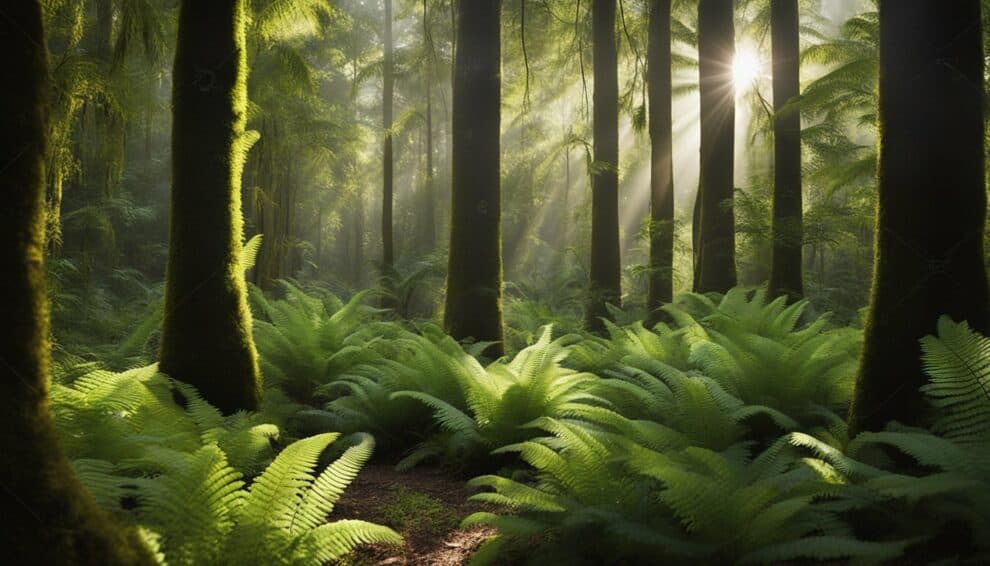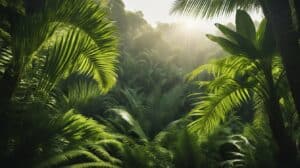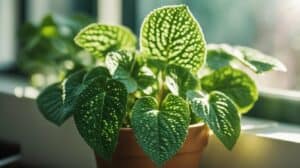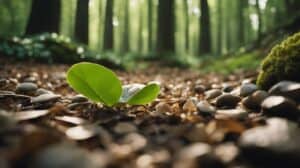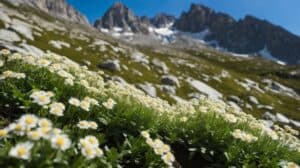Dicksonia Antarctica, also known as the soft tree fern, is a stunning plant that has been around for millions of years.
It is native to Australia, New Zealand, and some parts of South America.
This plant is a favorite among gardeners and plant enthusiasts due to its unique appearance and ease of care.

The soft tree fern is a slow-growing plant that can reach up to 20 feet in height. Its fronds are soft and delicate, giving it a graceful appearance.
The plant is able to thrive in a variety of conditions, making it a popular choice for both indoor and outdoor settings.
It can tolerate both shade and partial sun, and requires moist soil to grow.
In this beginner’s guide to the soft tree fern, readers will learn about the history and characteristics of this fascinating plant, as well as tips for caring for it.
Whether you are a seasoned gardener or just starting out, this guide will provide you with the information you need to successfully grow and maintain a beautiful soft tree fern.
Understanding Dicksonia Antarctica
Species Overview
Dicksonia Antarctica, also known as the Soft Tree Fern, is a species of tree fern that belongs to the family Dicksoniaceae.
It is native to southeastern Australia, Tasmania, and New Zealand.
This fern is one of the most popular tree ferns in cultivation, thanks to its attractive appearance and ease of care.
The Soft Tree Fern can grow up to 15 meters in height, with a trunk that can reach up to 50 centimeters in diameter.
The fronds of the fern are large, reaching up to 3 meters in length, and are a beautiful shade of green.
The fronds are also soft and delicate, which is where the fern gets its common name.
Habitat and Distribution
The Soft Tree Fern is native to southeastern Australia, Tasmania, and New Zealand.
In the wild, it can be found growing in moist, shady areas, such as rainforests, gullies, and stream banks.
This fern prefers a cool, humid environment and is well-suited to growing in areas with high rainfall.
The Soft Tree Fern is a popular ornamental plant and is often grown in gardens and parks around the world.
It is also commonly used in landscaping projects and can be found in many public spaces, such as botanical gardens and parks.
Overall, Dicksonia Antarctica is a beautiful and easy-to-care-for tree fern that is well-suited to a wide range of growing conditions.
Whether you are a seasoned gardener or a beginner, this fern is sure to be a great addition to your collection.
Cultivation and Care

Planting Guidelines
Dicksonia Antarctica, also known as the Soft Tree Fern, is a great addition to any garden or landscape.
When planting, it is important to choose a location that provides partial to full shade and moist, well-drained soil.
The fern can grow up to 10 feet in height and requires plenty of space to spread out.
To plant, dig a hole that is slightly larger than the root ball of the fern and fill it with a mixture of compost and soil.
Gently place the fern in the hole and backfill with soil, making sure to keep the top of the root ball level with the surrounding soil.
Water thoroughly after planting.
Watering and Feeding
Dicksonia Antarctica requires regular watering to keep the soil moist. During the hot summer months, it may be necessary to water the fern daily.
It is important to avoid letting the soil dry out completely, as this can cause the fern to wilt and die.
Feeding the fern with a balanced fertilizer once a month during the growing season can help promote healthy growth.
Be sure to follow the manufacturer’s instructions for application rates.
Common Pests and Diseases
The Soft Tree Fern is relatively pest and disease resistant, but there are a few issues to watch out for.
Scale insects and mealybugs can be a problem, especially in humid conditions. These pests can be controlled with insecticidal soap or horticultural oil.
Fungal diseases such as root rot can also be a concern, especially if the soil is too wet.
To prevent this, make sure the soil is well-drained and avoid overwatering.
If you notice any signs of disease, such as yellowing leaves or wilting, remove the affected fronds and treat with a fungicide if necessary.
By following these simple cultivation and care guidelines, you can enjoy the beauty of the Soft Tree Fern in your garden for years to come.
Propagation and Growth

Spore Propagation
Dicksonia Antarctica can be propagated through spores. Spores are tiny, dust-like particles that are produced by the fern’s fronds.
To collect spores, wait until the fronds are mature and have turned brown. Then, cut off a frond and place it in a paper bag.
After a few days, the spores will be released and can be collected from the bottom of the bag.
To propagate the fern from spores, prepare a mixture of peat moss and sand and fill a small pot with it.
Sprinkle the spores on top of the soil and cover the pot with plastic wrap to create a humid environment.
Keep the pot in a warm, bright location and mist the soil regularly. After a few weeks, small ferns will begin to grow.
Growth Rate and Mature Size
Dicksonia Antarctica grows relatively slowly, typically adding only a few inches of height per year.
However, the fern can eventually reach a mature size of up to 20 feet tall and 10 feet wide.
The fern prefers a shady, moist environment and should be planted in well-draining soil.
To encourage growth, fertilize the fern with a balanced fertilizer in the spring and summer. Prune any dead or damaged fronds to keep the plant healthy.
With proper care, Dicksonia Antarctica can be a beautiful and long-lived addition to any garden.
Conservation and Environmental Impact

Dicksonia Antarctica is a species that is currently listed as “Least Concern” on the IUCN Red List of Threatened Species.
However, there are still concerns about the impact that human activity can have on its populations.
One significant threat to the species is habitat loss.
As human populations continue to expand and encroach on natural areas, the habitats of many species, including Dicksonia Antarctica, are being destroyed.
This can lead to a decline in populations and even extinction in some cases.
Another potential threat to the species is climate change.
As temperatures rise and weather patterns shift, the conditions that are necessary for the growth and survival of Dicksonia Antarctica may become less favorable.
This could lead to a decline in populations or even local extinctions.
To mitigate these threats, it is important to take steps to protect the natural habitats of the species and to reduce the impact of human activity on these areas.
This can include measures such as habitat restoration and conservation programs, as well as efforts to reduce carbon emissions and combat climate change.
Overall, while Dicksonia Antarctica is currently not considered to be at high risk of extinction, it is important to take steps to protect its populations and ensure that it continues to thrive in its natural habitats.
Frequently Asked Questions

How should I care for Dicksonia antarctica during the winter months?
During the winter months, it’s important to protect your tree fern from frost and cold winds.
You can do this by wrapping the trunk with hessian or fleece and covering the crown with a layer of straw or bracken.
It’s also important to keep the soil moist but not waterlogged, as tree ferns can suffer from root rot if they are left in standing water.
What are the common issues with tree ferns and how can I address them?
The most common issues with tree ferns are pests and diseases.
Scale insects and mealybugs can be a problem, as can fungal diseases like root rot and crown rot.
To address these issues, it’s important to keep your tree fern healthy and well-fed.
You can also use insecticides and fungicides to treat pests and diseases.
Is it possible to propagate a tree fern by cutting it?
Yes, it is possible to propagate a tree fern by cutting it.
However, it can be difficult to do so successfully, as tree ferns are slow-growing and can take several years to reach maturity.
If you want to propagate your tree fern, it’s best to take a cutting from the base of the trunk and plant it in a pot filled with well-draining soil.
What are the best conditions for growing an Australian tree fern indoors?
Australian tree ferns thrive in bright, indirect light and high humidity. They also prefer well-draining soil that is kept moist but not waterlogged.
If you’re growing your tree fern indoors, it’s important to mist the leaves regularly and to keep the soil moist by watering it once or twice a week.
Are tree ferns considered annuals or perennials?
Tree ferns are considered perennials, as they can live for many years if they are well-cared for.
However, they are not fully hardy and may need protection during the winter months in colder climates.
What color variations can I expect from tree ferns?
Tree ferns come in a range of different colors, from bright green to dark brown.
The color of the trunk and fronds can also change as the tree fern ages, with older fronds turning brown and shedding to reveal the trunk underneath.






